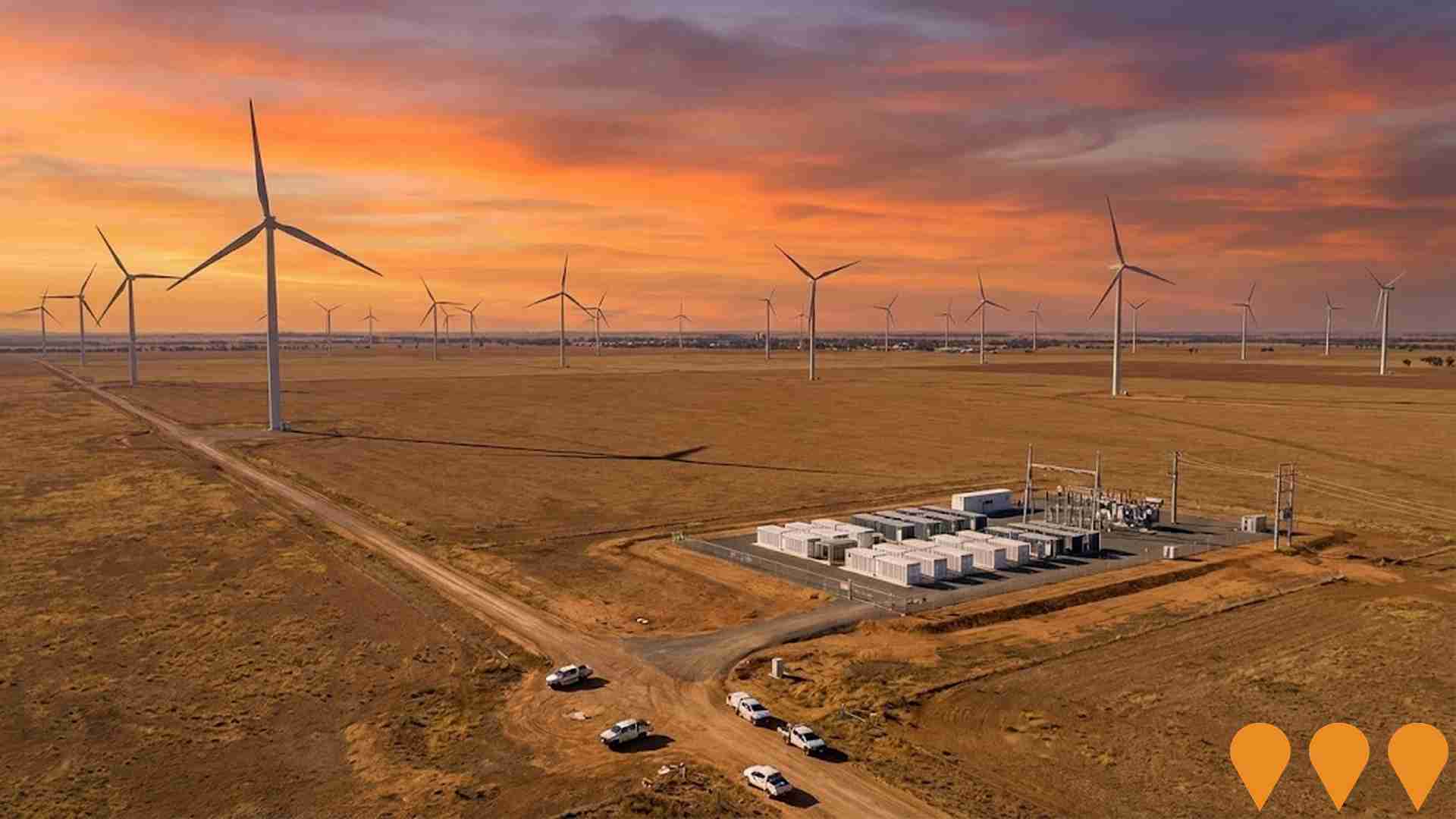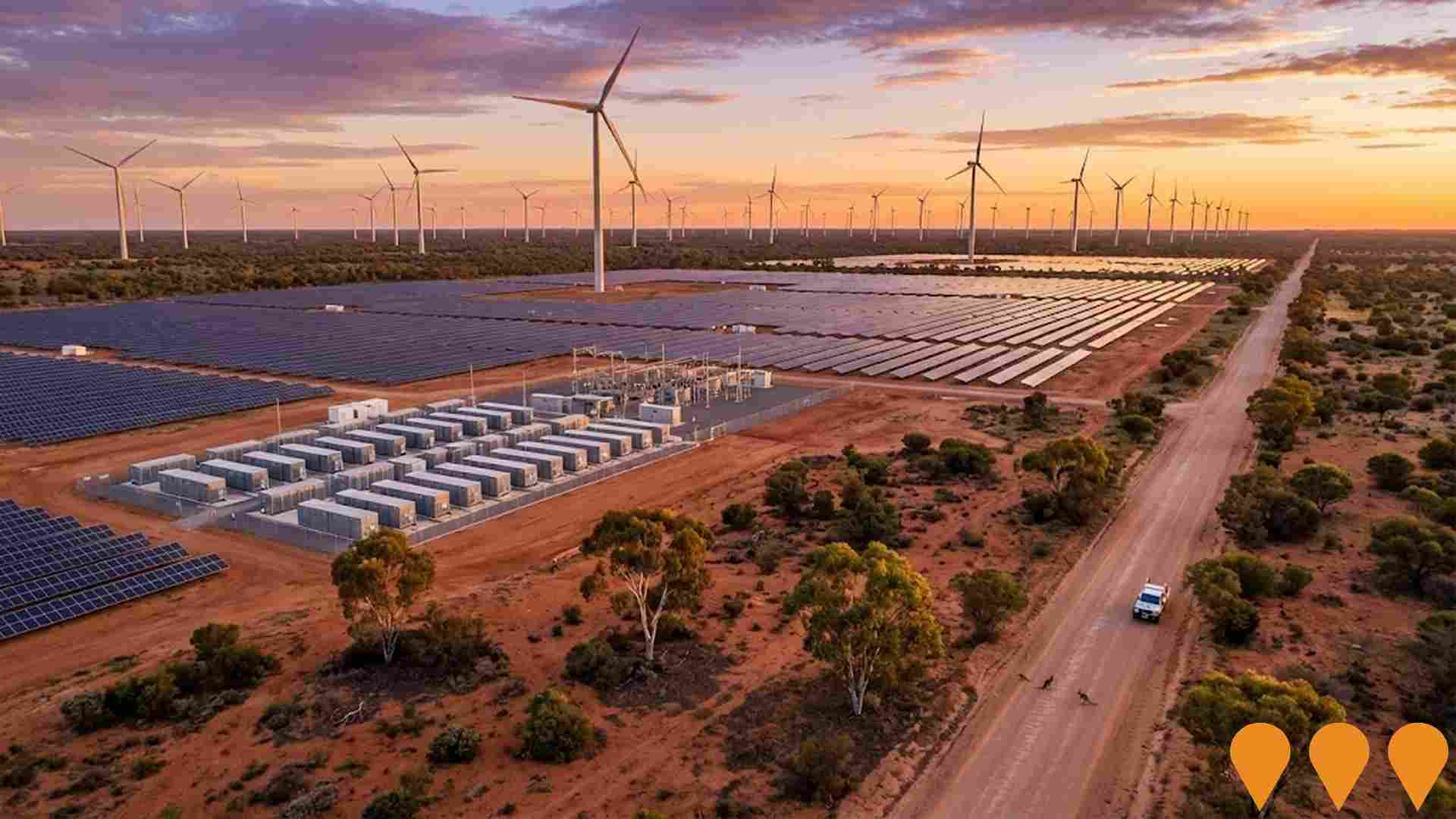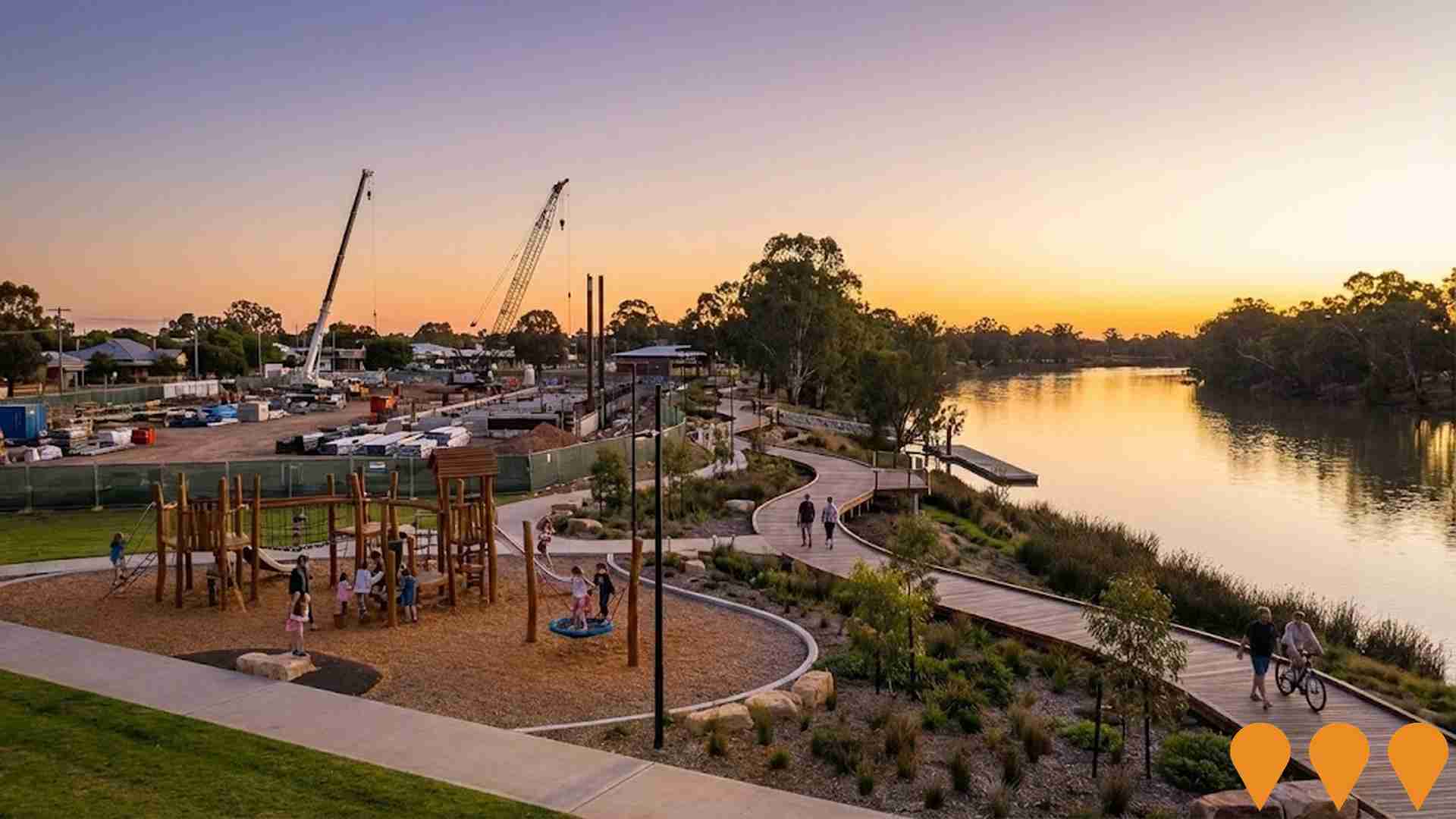Chart Color Schemes
est. as @ -- *
ABS ERP | -- people | --
2021 Census | -- people
Sales Activity
Curious about local property values? Filter the chart to assess the volume and appreciation (including resales) trends and regional comparisons, or scroll to the map below view this information at an individual property level.
Find a Recent Sale
Sales Detail
Population
Wentworth-Balranald Region has shown very soft population growth performance across periods assessed by AreaSearch
Based on AreaSearch's analysis, Wentworth-Balranald Region's population is around 3749 as of Aug 2025. This reflects an increase of 101 people, a 2.8% rise since the 2021 Census which reported a population of 3648 people. The change is inferred from the estimated resident population of 3677 in June 2024 and an additional 38 validated new addresses since the Census date. This level of population equates to a density ratio of 0.10 persons per square kilometer. Wentworth-Balranald Region's 2.8% growth since census positions it within 2.0 percentage points of the SA3 area, demonstrating competitive growth fundamentals. Population growth for the area was primarily driven by natural growth contributing approximately 53.6% of overall population gains during recent periods.
AreaSearch is adopting ABS/Geoscience Australia projections for each SA2 area, as released in 2024 with 2022 as the base year. For any SA2 areas not covered by this data, AreaSearch is utilising the NSW State Government's SA2 level projections, as released in 2022 with 2021 as the base year. Growth rates by age group from these aggregations are also applied to all areas for years 2032 to 2041. Looking at population projections moving forward, Over this period, projections indicate a decline in overall population, with the area's population expected to contract by 462 persons by 2041 according to this methodology. However, growth across specific age cohorts is anticipated, led by the 85 and over age group, which is projected to increase by 18 people.
Frequently Asked Questions - Population
Development
AreaSearch assessment of residential development drivers sees a low level of activity in Wentworth-Balranald Region, placing the area among the bottom 25% of areas assessed nationally
Wentworth-Balranald Region has approved approximately 9 residential properties each year over the past 5 financial years, totalling 48 homes. As of FY26, 2 approvals have been recorded. The region's population decline suggests new supply is meeting demand, providing good buyer choice while construction values average $626,000, moderately above regional levels. This year, $9.6 million in commercial approvals have been registered, indicating steady investment activity.
Compared to Rest of NSW, Wentworth-Balranald Region shows 61% of the construction activity per person and ranks among the 38th percentile nationally, suggesting relatively constrained buyer choice and interest in existing properties. Recent building activity consists solely of standalone homes, preserving low density nature with detached housing attracting space-seeking buyers. The area has an estimated 471 people per dwelling approval. With stable or declining population projections, reduced housing demand pressures are expected, benefiting potential buyers.
With population projections showing stability or decline, Wentworth-Balranald Region should see reduced housing demand pressures, benefiting potential buyers.
Frequently Asked Questions - Development
Infrastructure
Wentworth-Balranald Region has moderate levels of nearby infrastructure activity, ranking in the 42ndth percentile nationally
The performance of a region can significantly be influenced by changes in its local infrastructure, major projects, and planning initiatives. AreaSearch has identified 71 such projects that could potentially impact the area. Notable among these are Koorakee Energy Park, Euston Critical Minerals Project, Nyah Netball Courts and Lighting project, and Robinvale Netball Courts Lighting Project, with the following list providing more details on those most likely to be relevant.
Professional plan users can use the search below to filter and access additional projects.
INFRASTRUCTURE SEARCH
 Denotes AI-based impression for illustrative purposes only, not to be taken as definitive under any circumstances. Please follow links and conduct other investigations from the project's source for actual imagery. Developers and project owners wishing us to use original imagery please Contact Us and we will do so.
Denotes AI-based impression for illustrative purposes only, not to be taken as definitive under any circumstances. Please follow links and conduct other investigations from the project's source for actual imagery. Developers and project owners wishing us to use original imagery please Contact Us and we will do so.
Frequently Asked Questions - Infrastructure
Euston Wind Farm
A proposed 700 MW wind farm with up to 96 wind turbines and a 500 MW / 2,000 MWh battery energy storage system (BESS), located 8 km north of Euston in the NSW Riverina region. The project is expected to power approximately 325,000 homes annually.

Koorakee Energy Park
A proposed 2 GW renewable energy park within the South West Renewable Energy Zone, including up to 1 GW solar, up to 1 GW wind (up to 167 turbines, ~270 m tip height) and a 1 GW/12 GWh battery energy storage system. Located approximately 12 km north of Euston in Balranald Shire, the project is currently preparing an Environmental Impact Statement (EIS).

Robinvale Riverfront Masterplan
Comprehensive masterplan adopted by Swan Hill Rural City Council in March 2024 to revitalise the Robinvale Riverfront area. Key elements include the recently opened $2 million Robinvale Nature and Adventure Play (Ngiwa Kulaithi) in Centenary Park, a new skate park, and the Terrace Wharf redevelopment. The project aims to enhance community and cultural spaces, improve accessibility, and create a vibrant riverfront precinct. Further works are planned as funding becomes available.

EnergyConnect
Australia's largest energy transmission project. A new ~900km interconnector linking the NSW, SA and VIC grids. NSW-West (Buronga to SA border and Red Cliffs spur) was energised in 2024-2025, connecting the three states via the expanded Buronga substation. NSW-East (Buronga-Dinawan-Wagga Wagga) is under active construction with substation upgrades at Wagga Wagga completed in June 2025 and works well advanced at Dinawan and Buronga. Full 800MW transfer capability is targeted after completion of the eastern section and inter-network testing, expected by late 2027.

Robinvale Nature and Adventure Playground Ngiwa Kulaithi
The 5,000 square meter play precinct, named Ngiwa Kulaithi (meaning 'to sit river' in Latji Latji language), features a double twist slide, an all-abilities play tower and swing, junior Murray Cod play structure, water-play areas, a tunnel mound, sandpit, swings, bounce pads, and a skate park. The precinct incorporates shade structures, lily pad shade shelters, landscaping, all-abilities accessible paths, and local First Nations artwork. It is a key initiative of the Robinvale Riverfront Masterplan and is a significant community asset.

Robinvale Key Worker Accommodation
Transformation of the former kindergarten site into 10 modern dwellings (8 two-bedroom and 2 three-bedroom units) to provide affordable and stable housing for essential key workers in the Robinvale region, addressing the critical local housing shortage. The project is funded through the Victorian Government's Regional Worker Accommodation Fund (RWAF). Civil works commenced in mid-June 2025.

Swan Hill Worker Housing Project - Ronald Street
Two-stage development for worker accommodation in the Mallee region. Stage one, consisting of four three-bedroom houses, is complete and ready for move-in, with one house already sold. The homes provide accommodation for vital workers in industries like healthcare and education. Stage two involves four additional houses planned by Swan Hill Rural City Council for the site.

River Estate
Residential land subdivision in Euston releasing serviced lots (Stage 3 active) within walking distance of the Murray River and local amenities. Lots have underground services to the boundary (power, dual water, sewer).

Employment
Employment conditions in Wentworth-Balranald Region demonstrate exceptional strength compared to most Australian markets
The Wentworth-Balranald Region has a balanced workforce with diverse sector representation as of June 2025. It has an unemployment rate of 2.1%, which is 1.6% lower than the Rest of NSW's rate of 3.7%.
The region experienced an employment growth of 4.8% in the past year. There are 2,281 residents employed currently, with workforce participation similar to the Rest of NSW at 56.4%. Key industries include agriculture, forestry & fishing, health care & social assistance, and education & training. The region has a significant specialization in agriculture, forestry & fishing, with an employment share 7.7 times the regional level.
However, health care & social assistance has limited presence at 8.6% compared to the regional average of 16.9%. Many residents commute elsewhere for work based on Census data. Between June 2024 and June 2025, employment levels increased by 4.8%, labour force increased by 4.6%, and unemployment fell by 0.1 percentage points. In contrast, the Rest of NSW saw a decrease in employment by 0.1%, an increase in labour force by 0.3%, and a rise in unemployment by 0.4 percentage points. National employment forecasts from Jobs and Skills Australia, released in May 2025, project national growth rates of 6.6% over five years and 13.7% over ten years. Applying these projections to the local employment mix suggests potential growth for Wentworth-Balranald Region of approximately 4.5% over five years and 10.5% over ten years.
Frequently Asked Questions - Employment
Income
Income figures position the area below 75% of locations analysed nationally by AreaSearch
Wentworth-Balranald Region's median income among taxpayers in financial year 2022 was $44,594. The average income stood at $52,458 during the same period. For comparison, Rest of NSW had a median income of $49,459 and an average income of $62,998. By September 2025, estimates suggest Wentworth-Balranald Region's median income will be approximately $50,217 and the average income around $59,073, based on a 12.61% growth in wages since financial year 2022. Census data indicates household, family, and personal incomes rank modestly in Wentworth-Balranald Region, between the 29th and 38th percentiles. The $1,500 - 2,999 income bracket dominated with 32.4% of residents (1,214 people), mirroring broader trends across the region where 29.9% fell into this category. Housing costs were manageable with 91.7% retained, but disposable income was below average at the 38th percentile.
Frequently Asked Questions - Income
Housing
Wentworth-Balranald Region is characterized by a predominantly suburban housing profile, with above-average rates of outright home ownership
The latest Census evaluation shows that within the Wentworth-Balranald Region, 93.7% of dwellings are houses, with the remaining 6.3% being semi-detached homes, apartments, or other types of dwellings. This compares to Non-Metro NSW's 92.7% houses and 7.2% other dwellings. Home ownership in Wentworth-Balranald Region stands at 48.5%, with mortgaged properties making up 27.1% and rented dwellings accounting for 24.4%. The median monthly mortgage repayment in the area is $1,083, lower than Non-Metro NSW's average of $1,179. The median weekly rent figure is $200, which is also lower than the national average of $375. Nationally, Wentworth-Balranald Region's mortgage repayments are significantly lower than the Australian average of $1,863.
Frequently Asked Questions - Housing
Household Composition
Wentworth-Balranald Region has a typical household mix, with a higher-than-average median household size
Family households constitute 70.8% of all households, including 28.0% couples with children, 32.9% couples without children, and 8.8% single parent families. Non-family households comprise the remaining 29.2%, with lone person households at 26.4% and group households making up 3.1%. The median household size is 2.5 people, larger than the Rest of NSW average of 2.4.
Frequently Asked Questions - Households
Local Schools & Education
Wentworth-Balranald Region faces educational challenges, with performance metrics placing it in the bottom quartile of areas assessed nationally
The area faces educational challenges, with university qualification rates at 13.0%, substantially below the NSW average of 32.2%. This represents both a challenge and an opportunity for targeted educational initiatives. Bachelor degrees lead at 10.2%, followed by graduate diplomas at 1.5% and postgraduate qualifications at 1.3%. Trade and technical skills feature prominently, with 39.6% of residents aged 15+ holding vocational credentials – advanced diplomas at 9.6% and certificates at 30.0%.
Educational participation is notably high, with 32.4% of residents currently enrolled in formal education. This includes 13.9% in primary education, 9.8% in secondary education, and 1.9% pursuing tertiary education. A robust network of eight schools operates within Wentworth-Balranald Region, educating approximately five hundred ten students. The educational mix includes six primary schools and two K-12 schools.
Frequently Asked Questions - Education
Schools Detail
Nearby Services & Amenities
Transport
Transport servicing is low compared to other areas nationally based on assessment of service frequency, route connectivity and accessibility
The Wentworth-Balranald Region has 143 active public transport stops. These include train and bus services operating through the region. There are 22 individual routes serving these stops, providing a total of 235 weekly passenger trips combined.
The accessibility of public transport is rated as limited in this area. Residents typically live 7687 meters away from their nearest transport stop. On average, there are 33 trips per day across all routes, which equates to approximately one weekly trip per individual stop.
Frequently Asked Questions - Transport
Transport Stops Detail
Health
Wentworth-Balranald Region's residents are relatively healthy in comparison to broader Australia with a fairly standard level of common health conditions seen across both young and old age cohorts
The Wentworth-Balranald Region's health metrics closely align with national benchmarks, showing a typical distribution of common health conditions across both young and elderly residents. Private health cover is exceptionally low at approximately 46% (1,732 people), compared to the national average of 55.3%.
The most prevalent medical conditions are arthritis and asthma, affecting 8.5 and 8.1% of residents respectively. Notably, 70.5% of residents report no medical ailments, higher than the Rest of NSW's figure of 65.8%. The region has a lower proportion of seniors aged 65 and over at 21.9% (820 people), compared to Rest of NSW's 22.9%. Health outcomes among seniors in the region are above average, outperforming even the general population in health metrics.
Frequently Asked Questions - Health
Cultural Diversity
Wentworth-Balranald Region ranks below the Australian average when compared to other local markets across a number of language and cultural background related metrics
Wentworth-Balranald Region had a cultural diversity index below the average, with 79.0% of its population being citizens, 89.4% born in Australia, and 89.6% speaking English only at home. Christianity was the predominant religion, comprising 57.8% of the region's population, compared to 57.0% across Rest of NSW. The top three ancestry groups were Australian (29.5%), English (29.3%), and Scottish (8.1%).
Notably, Italian ancestry was overrepresented at 7.6%, while Australian Aboriginal was underrepresented at 4.2%. Samoan ancestry was present but not significantly represented at 0.2%.
Frequently Asked Questions - Diversity
Age
Wentworth-Balranald Region hosts an older demographic, ranking in the top quartile nationwide
The median age in Wentworth-Balranald Region is 43, matching Rest of NSW's figure and exceeding Australia's national average of 38 years. The region's age profile shows a prominent percentage (14.5%) of individuals aged 55-64, while those aged 15-24 comprise a smaller proportion (8.6%) compared to Rest of NSW. Between the 2021 Census and present, the 35-44 age group has increased from 10.9% to 12.8%, and the 65-74 cohort has risen from 12.3% to 13.5%. Conversely, the 45-54 cohort has decreased from 13.5% to 11.8%, and the 25-34 group has fallen from 12.8% to 11.5%. By 2041, demographic projections indicate significant shifts in Wentworth-Balranald Region's age structure. Notably, the 85+ group is expected to grow by 16 people, reaching 102 from 87, and the combined 65+ age groups will account for all population growth, reflecting the area's aging demographic trend. Conversely, the 75-84 and 25-34 cohorts are projected to experience population declines.

